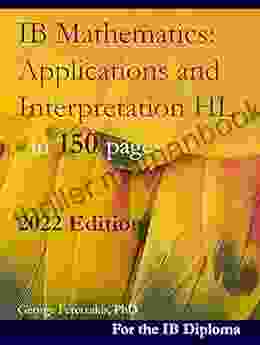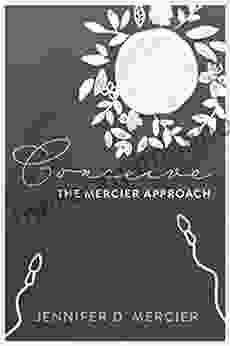Applications and Interpretation HL in 150 Pages: A Comprehensive Guide for IB Diploma Students

Applications and Interpretation HL is a demanding but rewarding course offered by the International Baccalaureate (IB) Diploma Programme. It is designed to develop students' analytical, interpretive, and critical thinking skills through the study of a variety of literary and non-literary texts.
This guide has been written to provide students with a comprehensive overview of the Applications and Interpretation HL course. It covers all of the key concepts, theories, and texts that students will need to know for the exam. It also includes a wealth of practice questions and sample essays to help students prepare for the exam.
The first section of this guide introduces students to the nature of literature. It explores the different definitions of literature, the elements of literature, and the different ways that literature can be interpreted.
5 out of 5
| Language | : | English |
| File size | : | 15758 KB |
| Print length | : | 155 pages |
| Lending | : | Enabled |
| Screen Reader | : | Supported |
There is no single, universally agreed-upon definition of literature. However, most definitions share some common elements. For example, literature is often defined as a written or spoken work of art that uses language in a creative and imaginative way. Literature can be fiction or non-fiction, and it can take many different forms, including novels, short stories, poems, plays, and essays.
The elements of literature are the building blocks that make up a literary work. These elements include:
- Plot: The sequence of events that occur in a literary work.
- Character: The people or animals who appear in a literary work.
- Setting: The time and place in which a literary work is set.
- Theme: The central idea or message that a literary work conveys.
- Style: The way in which a literary work is written.
There is no one "correct" interpretation of a literary work. The meaning of a literary work is ultimately up to the individual reader to decide. However, there are a number of different approaches to interpreting literature that can help readers to understand a work more deeply. Some of these approaches include:
- Close reading: This approach involves reading a text carefully and paying attention to the details.
- Contextualization: This approach involves understanding the historical and cultural context in which a work was written.
- Deconstruction: This approach involves breaking down a text and examining its underlying structures.
- Psychoanalysis: This approach involves using psychological principles to interpret a text.
The second section of this guide focuses on the interpretation of texts. It explores the different ways that readers can interpret texts, and it provides a number of strategies for interpreting texts effectively.
Reader-response theory is a theory of literary criticism that emphasizes the role of the reader in the interpretation of a text. This theory suggests that the meaning of a text is not fixed, but rather is created by the reader through the act of reading.
There are a number of different strategies that readers can use to interpret texts effectively. These strategies include:
- Asking questions: Asking questions about a text can help readers to identify the key points and themes of the text.
- Making connections: Making connections between different parts of a text can help readers to understand the structure and meaning of the text.
- Inferring: Inferring information that is not explicitly stated in a text can help readers to fill in the gaps and understand the text more fully.
- Evaluating: Evaluating the text's strengths and weaknesses can help readers to form a more informed opinion about the text.
The third section of this guide focuses on the application of texts. It explores the different ways that texts can be used to communicate ideas and information.
Texts can be used to persuade readers to believe or do something. Advertisers, politicians, and other writers often use persuasive techniques to influence their audiences.
Texts can also be used to inform readers about a particular topic. News articles, textbooks, and other informational texts provide readers with the knowledge they need to make informed decisions.
Texts can also be used to entertain readers. Novels, short stories, poems, and other literary works can provide readers with escapism, laughter, and a sense of wonder.
The fourth section of this guide provides advice on how to write an extended essay in Applications and Interpretation HL. The extended essay is a 4,000-word research paper that students must complete as part of the IB Diploma Programme.
The first step in writing an extended essay is to choose a topic. The topic should be something that the student is interested in and that is appropriate for the course.
Once the student has chosen a topic, they must research the topic thoroughly. This involves reading books, articles, and other sources of information.
The extended essay should be written in a clear and concise style. The essay should be well-organized and should flow smoothly from one section to the next.
The student must cite all of the sources that they use in their extended essay. This helps to ensure that the student is not plagiarizing and that the reader can verify the information in the essay.
The fifth section of this guide provides a number of sample essays that students can use to help them prepare for the exam. These essays cover a variety of topics and demonstrate the different ways that students can approach the extended essay.
This guide provides students with a comprehensive overview of the Applications and Interpretation HL course. It covers all of the key concepts, theories, and texts that students will need to know for the exam. It also includes a wealth of practice questions and sample essays to help students prepare for the exam.
With hard work and dedication, students can achieve success in Applications and Interpretation HL. This guide will help students to develop the skills and knowledge they need to succeed in this challenging but rewarding course.
5 out of 5
| Language | : | English |
| File size | : | 15758 KB |
| Print length | : | 155 pages |
| Lending | : | Enabled |
| Screen Reader | : | Supported |
Do you want to contribute by writing guest posts on this blog?
Please contact us and send us a resume of previous articles that you have written.
 Top Book
Top Book Novel
Novel Fiction
Fiction Nonfiction
Nonfiction Literature
Literature Paperback
Paperback Hardcover
Hardcover E-book
E-book Audiobook
Audiobook Bestseller
Bestseller Classic
Classic Mystery
Mystery Thriller
Thriller Romance
Romance Fantasy
Fantasy Science Fiction
Science Fiction Biography
Biography Memoir
Memoir Autobiography
Autobiography Poetry
Poetry Drama
Drama Historical Fiction
Historical Fiction Self-help
Self-help Young Adult
Young Adult Childrens Books
Childrens Books Graphic Novel
Graphic Novel Anthology
Anthology Series
Series Encyclopedia
Encyclopedia Reference
Reference Guidebook
Guidebook Textbook
Textbook Workbook
Workbook Journal
Journal Diary
Diary Manuscript
Manuscript Folio
Folio Pulp Fiction
Pulp Fiction Short Stories
Short Stories Fairy Tales
Fairy Tales Fables
Fables Mythology
Mythology Philosophy
Philosophy Religion
Religion Spirituality
Spirituality Essays
Essays Critique
Critique Commentary
Commentary Glossary
Glossary Bibliography
Bibliography Index
Index Table of Contents
Table of Contents Preface
Preface Introduction
Introduction Foreword
Foreword Afterword
Afterword Appendices
Appendices Annotations
Annotations Footnotes
Footnotes Epilogue
Epilogue Prologue
Prologue Kim Stanley Robinson
Kim Stanley Robinson Matthew Zapruder
Matthew Zapruder Robert Mcnally
Robert Mcnally Joann S Grohman
Joann S Grohman Brendan Noble
Brendan Noble Melissa Samaroo
Melissa Samaroo Michael Payne
Michael Payne Markater C
Markater C Jeff Lindsay
Jeff Lindsay Ramy Vance
Ramy Vance Francis D K Ching
Francis D K Ching Patrick Wang
Patrick Wang Vishal Gupta
Vishal Gupta Dick Gephardt
Dick Gephardt Malachi Jenkins
Malachi Jenkins Koraly Dimitriadis
Koraly Dimitriadis John C Duval
John C Duval Matthew Campbell
Matthew Campbell Jane Hardy
Jane Hardy Helen E Fisher
Helen E Fisher
Light bulbAdvertise smarter! Our strategic ad space ensures maximum exposure. Reserve your spot today!

 Gabriel Garcia MarquezHow to Find and Keep Lasting Love: A Comprehensive Guide to Finding Your...
Gabriel Garcia MarquezHow to Find and Keep Lasting Love: A Comprehensive Guide to Finding Your... Finn CoxFollow ·7.9k
Finn CoxFollow ·7.9k Dylan MitchellFollow ·12.3k
Dylan MitchellFollow ·12.3k Earl WilliamsFollow ·15.9k
Earl WilliamsFollow ·15.9k Leo MitchellFollow ·8k
Leo MitchellFollow ·8k Chandler WardFollow ·19.2k
Chandler WardFollow ·19.2k Joseph ConradFollow ·8.8k
Joseph ConradFollow ·8.8k Gage HayesFollow ·8.4k
Gage HayesFollow ·8.4k Arthur MasonFollow ·6k
Arthur MasonFollow ·6k

 Caleb Carter
Caleb CarterThe Complete Beagle Dog Beginners Guide: Beagle Facts,...
Beagles are...
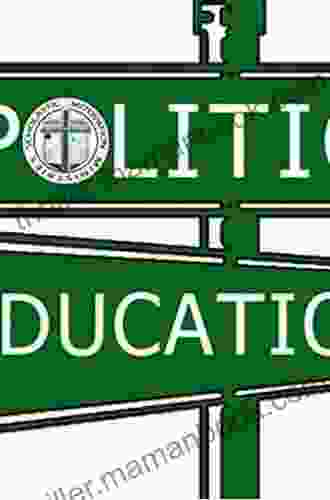
 Gage Hayes
Gage HayesThe Origins and Evolution of No Child Left Behind:...
The No Child Left Behind...
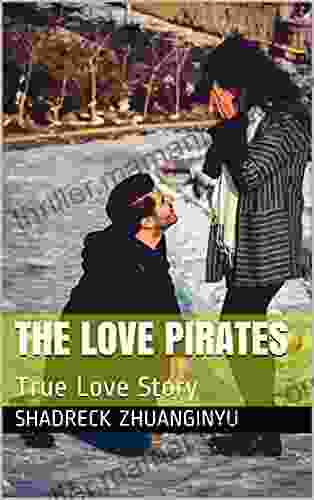
 George Martin
George MartinThe Love Pirates: A Swashbuckling Tale of Love,...
The Love Pirates is a thrilling...
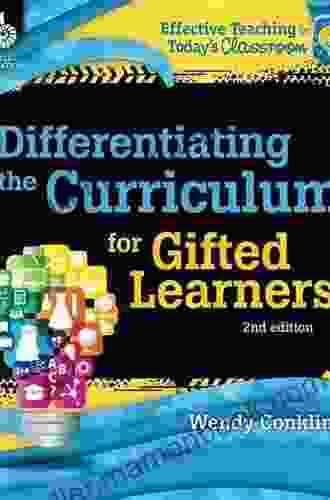
 Nathaniel Hawthorne
Nathaniel HawthorneDifferentiating the Curriculum for Gifted Learners:...
Gifted learners are...
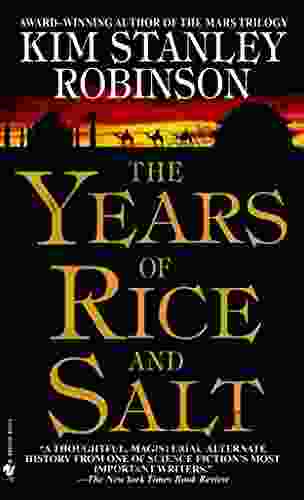
 Carlos Fuentes
Carlos FuentesThe Years of Rice and Salt: A Journey Through a Forgotten...
The Years of Rice and Salt is...
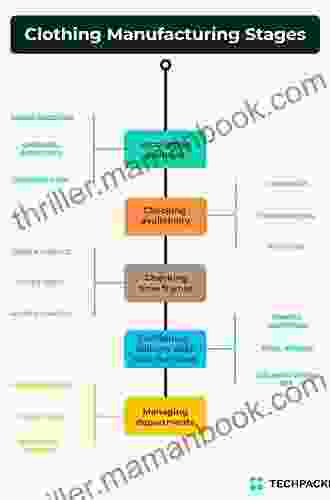
 Herbert Cox
Herbert CoxThe Intricate Design of Clothing Manufacturing Processes:...
The clothing industry is a vast and...
5 out of 5
| Language | : | English |
| File size | : | 15758 KB |
| Print length | : | 155 pages |
| Lending | : | Enabled |
| Screen Reader | : | Supported |


